Basildon University Hospital
Nethermayne, Basilson, Essex SS16 5NL
Medical
dates:
Medical
character:
Acute
In 1954 a campaign began in Basildon New Town
for a hospital to be built to serve the area. After long delays
and consultations, building work on the 32-acre site finally began in
1967.
Basildon Hospital opened on 1st April 1973. Its first patient was a 6-year-old girl from Tilbury. Despite six years of building work at a cost of £7m, the Hospital had not yet been completed. However, the maternity department was operational and a baby girl was born on 2nd April and a boy on 3rd April.
The Hospital was under the control of the South Essex Hospital Management Committee, part of the North East Metropolitan Regional Health Board.
Following a major reorganisation of the NHS in 1974, management of the Hospital passed to the Basildon and Thurrock District Health Authority, part of the Essex Area Health Authority.
After another major reorganisation of the NHS in 1982, control of the Hospital passed to the Basildon and Thurrock Health Authority.
In 1990 the Hospital had 363 beds, with an additional 90 beds in the Mental Illness Unit.
In 1991, with the introduction into the NHS of the marketplace system of providers and purchasers, the Hospital joined the Basildon and Thurrock General Hospitals NHS Trust.
In 1993 the Area Health Authority's maternity services were centralised and the Hospital's maternity unit was refurbished. The unit was opened by the Prime Minister, John Major, on 4th April 1994.
In 2001, however, the severe shortage of beds led to the Royal College of Nursing describing conditions at the Hospital as 'Third World'.
On 11th April 2003 Princess Anne officially opened a newly built ward block. The 3-storey building was named the Jubilee Wing in honour of the Queen's 50 year reign. It contained 321 beds in 12 wards.
On 1st April 2004 the Hospital came under the control of one of the first Foundation Trusts in the NHS - the Basildon and Thurrock University Hospitals NHS Foundation Trust.
In June 2004 the Arthur Rook Centre for Dermatology opened in a new purpose-built 2-storey building.
In 2003 the Foundation Trust was fined for failing to control the risk of legionnaire's disease after a patient contracted the infection.
In February 2005 building work began for a new 4-storey building to accommodate a cardiothoracic centre.
The £60m Essex Cardiothoracic Centre opened on 1st July 2007, with the first patients being seen on 2nd July. It was officially opened a few months later - on 4th October - by the Prime Minister, Gordon Brown.
On 12th March 2008 a £8m multi-story car park became operational. It had space for 1,600 vehicles on four levels. The previous car park, which had around 900 spaces, had been extended on leased land to provide an additional 320 spaces, but this had proved inadequate.
In April 2009 intravenous drip bags were found to have been tampered with after a 3-year-old girl died in the paediatric ward. In the same year some 200 new mothers were offered HIV tests after it was discovered that a member of the midwifery staff was HIV positive.
In 2009 a survey compiled by Dr Foster revealed that the Hospital had the worst death rates in the country - a third higher than they should have been - but senior managers initially dismissed the concerns.
The report mentioned poor nursing (failure to administer drugs correctly, to monitor patients and to feed them; bed sores were found in twice as many patients as the national average), dirty wards (stained floors and curtains, badly soiled mattresses, blood splattered trays and mould on vital equipment, some of which was past its 'use-by' date) and a lack of leadership by the Foundation Trust had contributed to 400 avoidable deaths during the year.
The Accident & Emergency Department was singled out for special concern. Patients had little privacy, with only curtains separating cubicles (half of them soiled, some with blood). Some patients were cared for on trolleys around the edge of the Major Injuries area, and even in the centre of the room in busier times. Eleven of the 12 trolley mattresses were stained and two had a foul odour. Some patients were left in the Department for up to 10 hours. Reusable equipment was not being decontaminated adequately. Few nurses had paediatric training and, overall, they failed to carry out a full set of patient checks, making it difficult to recognise if a patient was deteriorating.
An expert taskforce was sent into the Hospital to improve hygiene standards and patient care.
In 2010 a newly built Endoscopy Department opened to support the newly established Bowel Screening Service. The previous site of the Endoscopy Unit was converted into a Children's Accident & Emergency Department. Work began on a new Accident & Emergency Department which would provide segregated facilities for children and adults.
In August 2011 a new Fracture Clinic opened.
In March 2012 the purpose-built Children's Accident & Emergency Department opened - the first of its kind in Essex. A month later the adult side opened. The new unit had cost £17m. The new unit had been created by adding two extra floors to the existing building, which had then been refurbished and a new entrance installed.
In July 2013 the Foundation Trust was placed into special measures by Monitor. It was put into a 'buddying' arrangement with the Royal Free London NHS Foundation Trust.
By June 2014 the Hospital had made a remarkable turnaround and had come out of special measures. A radical overhaul of its corporate governance structure and risk management had improved its safety record. The CQC found significant improvements in services with the employment of agency staff.
In 2017 the X-ray Department was relocated and remodelled at a cost of £1.3m.
In 2018 work began on refurbishment and extension of the Women and Children's Department.
In 2019 the CQC found the overall state of the Hospital to be 'good'.
Basildon Hospital opened on 1st April 1973. Its first patient was a 6-year-old girl from Tilbury. Despite six years of building work at a cost of £7m, the Hospital had not yet been completed. However, the maternity department was operational and a baby girl was born on 2nd April and a boy on 3rd April.
The Hospital was under the control of the South Essex Hospital Management Committee, part of the North East Metropolitan Regional Health Board.
Following a major reorganisation of the NHS in 1974, management of the Hospital passed to the Basildon and Thurrock District Health Authority, part of the Essex Area Health Authority.
After another major reorganisation of the NHS in 1982, control of the Hospital passed to the Basildon and Thurrock Health Authority.
In 1990 the Hospital had 363 beds, with an additional 90 beds in the Mental Illness Unit.
In 1991, with the introduction into the NHS of the marketplace system of providers and purchasers, the Hospital joined the Basildon and Thurrock General Hospitals NHS Trust.
In 1993 the Area Health Authority's maternity services were centralised and the Hospital's maternity unit was refurbished. The unit was opened by the Prime Minister, John Major, on 4th April 1994.
In 2001, however, the severe shortage of beds led to the Royal College of Nursing describing conditions at the Hospital as 'Third World'.
On 11th April 2003 Princess Anne officially opened a newly built ward block. The 3-storey building was named the Jubilee Wing in honour of the Queen's 50 year reign. It contained 321 beds in 12 wards.
On 1st April 2004 the Hospital came under the control of one of the first Foundation Trusts in the NHS - the Basildon and Thurrock University Hospitals NHS Foundation Trust.
In June 2004 the Arthur Rook Centre for Dermatology opened in a new purpose-built 2-storey building.
In 2003 the Foundation Trust was fined for failing to control the risk of legionnaire's disease after a patient contracted the infection.
In February 2005 building work began for a new 4-storey building to accommodate a cardiothoracic centre.
The £60m Essex Cardiothoracic Centre opened on 1st July 2007, with the first patients being seen on 2nd July. It was officially opened a few months later - on 4th October - by the Prime Minister, Gordon Brown.
On 12th March 2008 a £8m multi-story car park became operational. It had space for 1,600 vehicles on four levels. The previous car park, which had around 900 spaces, had been extended on leased land to provide an additional 320 spaces, but this had proved inadequate.
In April 2009 intravenous drip bags were found to have been tampered with after a 3-year-old girl died in the paediatric ward. In the same year some 200 new mothers were offered HIV tests after it was discovered that a member of the midwifery staff was HIV positive.
In 2009 a survey compiled by Dr Foster revealed that the Hospital had the worst death rates in the country - a third higher than they should have been - but senior managers initially dismissed the concerns.
The report mentioned poor nursing (failure to administer drugs correctly, to monitor patients and to feed them; bed sores were found in twice as many patients as the national average), dirty wards (stained floors and curtains, badly soiled mattresses, blood splattered trays and mould on vital equipment, some of which was past its 'use-by' date) and a lack of leadership by the Foundation Trust had contributed to 400 avoidable deaths during the year.
The Accident & Emergency Department was singled out for special concern. Patients had little privacy, with only curtains separating cubicles (half of them soiled, some with blood). Some patients were cared for on trolleys around the edge of the Major Injuries area, and even in the centre of the room in busier times. Eleven of the 12 trolley mattresses were stained and two had a foul odour. Some patients were left in the Department for up to 10 hours. Reusable equipment was not being decontaminated adequately. Few nurses had paediatric training and, overall, they failed to carry out a full set of patient checks, making it difficult to recognise if a patient was deteriorating.
An expert taskforce was sent into the Hospital to improve hygiene standards and patient care.
In 2010 a newly built Endoscopy Department opened to support the newly established Bowel Screening Service. The previous site of the Endoscopy Unit was converted into a Children's Accident & Emergency Department. Work began on a new Accident & Emergency Department which would provide segregated facilities for children and adults.
In August 2011 a new Fracture Clinic opened.
In March 2012 the purpose-built Children's Accident & Emergency Department opened - the first of its kind in Essex. A month later the adult side opened. The new unit had cost £17m. The new unit had been created by adding two extra floors to the existing building, which had then been refurbished and a new entrance installed.
In July 2013 the Foundation Trust was placed into special measures by Monitor. It was put into a 'buddying' arrangement with the Royal Free London NHS Foundation Trust.
By June 2014 the Hospital had made a remarkable turnaround and had come out of special measures. A radical overhaul of its corporate governance structure and risk management had improved its safety record. The CQC found significant improvements in services with the employment of agency staff.
In 2017 the X-ray Department was relocated and remodelled at a cost of £1.3m.
In 2018 work began on refurbishment and extension of the Women and Children's Department.
In 2019 the CQC found the overall state of the Hospital to be 'good'.
Present status (March 2020)
The Hospital is currently operational. It has 777 beds and offers a wide range of medical and surgical services.
However, the latest figures show the Hospital to be already £5m over its planned end-of-year deficit of £12.2m. By the end of the financial year in April 2020, it expects to be £9.8m in deficit.
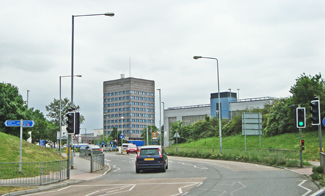
The entrance road to the Hospital.
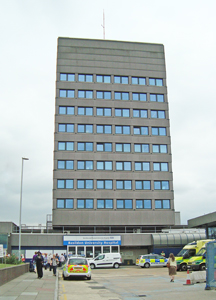
The main entrance of the Hospital.
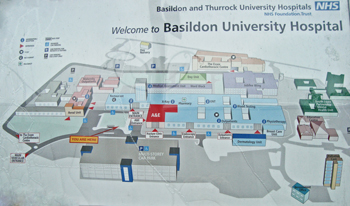
A map of the Hospital site.
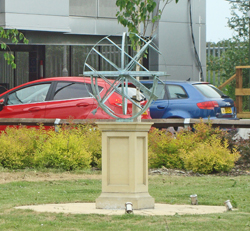
Modern sculpture within the grounds.
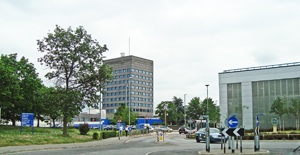
The tower block with the multi-storey car park on the right of the image.
Panniker C 2014 How Basildon hospital was turned around with honesty and transparency. The Guardian, 14th November.
Sexton C 2020 Basildon Hospital planning for £12m deficit and must use loans to pay staff. Echo News, 29th January.
Smith R 2009 Failing hospital condemns hundreds to death. The Telegraph, 27th November.
Smith R, Rayner G 2009 Fears over Basildon Hospital first raised in 2001. The Telegraph, 27th November.
https://api.parliament.uk (1)
https://api.parliament.uk (2)
https://discovery.nationalarchives.gov.uk
https://en.wikipedia.org
https://procure21plus.nhs.uk
www.basildon.com (1)
www.basildon.com (2)
www.basildon.com (3)
www.basildon.com (4)
www.basildon.com (5)
www.basildonandthurrock.nhs.uk
www.bbc.co.uk (1)
www.bbc.co.uk (2)
www.davisconsutrction.co.uk
www.eafa.org.uk
www.essexsounds.org.uk
www.fbbarchitects.com
www.hsj.co.uk
www.itv.com
www.loganconstruction.co.uk
Return to home page